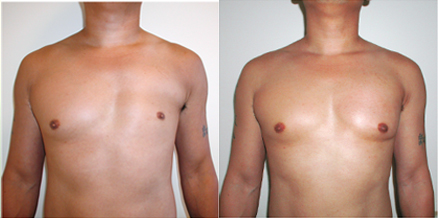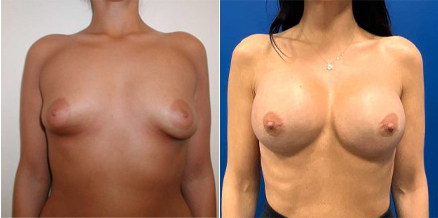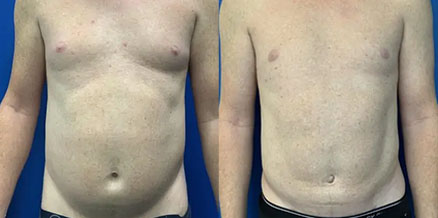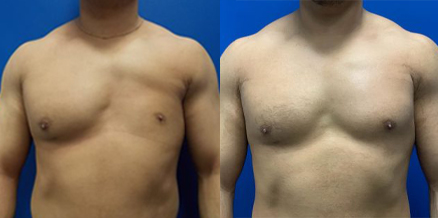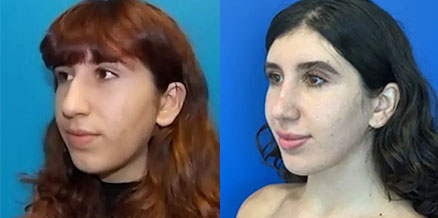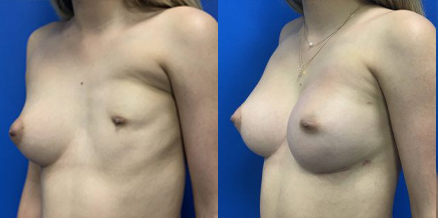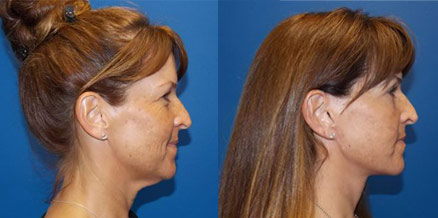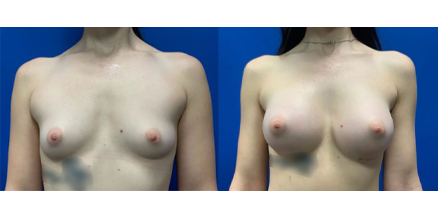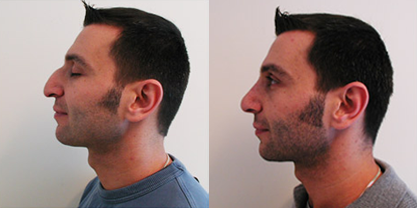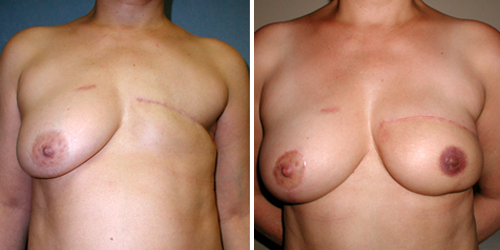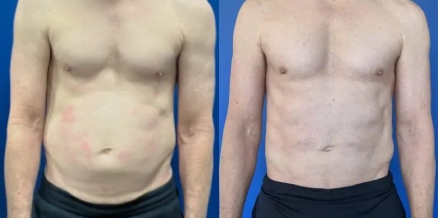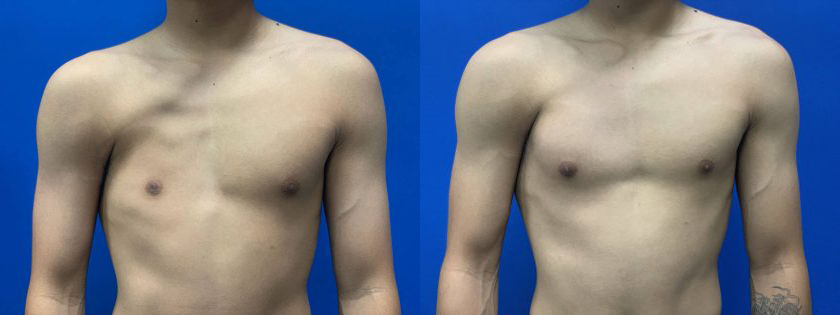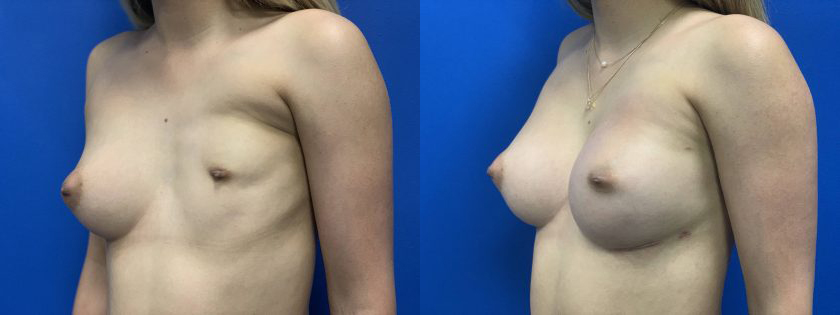Poland Syndrome
Conveniently located to serve the areas of Beverly Hills, West Hollywood, Los Angeles and Pasadena, CA

Poland Syndrome is a very rare congenital condition more commonly seen in men than in women. It is characterized by the partial or complete absence of the pectoralis major muscle on one side of the chest wall only: more commonly, the right side. The missing portion is most often the large or central and inferior part of the sternal attachment of the musculature but may also include the surrounding muscles. In some patients, it is not unusual for the nipple to be disproportionately small, higher in position, or entirely absent. In women with Poland Syndrome, in addition to the varying degrees of pectoral muscle absence, there can be a significant asymmetry in the appearance of the breast as well as the position and size of the nipple-areolar complex on the same side of the chest affected by Poland Syndrome.
Before and After Photos
View GalleryThe effects of Poland Syndrome can be a major source of self-consciousness and embarrassment. Women can conceal their breast and chest asymmetry with clothing; men, however, are usually bare-chested with certain sports and activities where they may feel hesitant to show their chest or torso which can be a source of undue stress and anxiety.
For individuals who struggle with the physical and psychological effects of Poland Syndrome, seeking the expertise of a skilled and attentive plastic surgeon can provide options for aesthetic improvement and symmetry. The creative details involved in the surgical correction for patients with Poland Syndrome literally express the meaning of the “art” in the medical profession where medicine is traditionally described as an art and a science. Therefore, a comprehensive evaluation by a plastic surgeon experienced in treating Poland Syndrome is essential for creating a personalized treatment plan.
If you have Poland Syndrome, Dr. Mossi Salibian can provide you with a more natural-looking solution. Depending on how your condition manifests, he can take a custom-designed approach to help restore your sense of body confidence. As an award-winning board-certified plastic and reconstructive surgeon and researcher, Dr. Salibian prides himself in building a personal rapport with each of his patients, ensuring that they make informed decisions regarding their health and appearance. The ultimate outcomes profoundly impact patients’ lives and are deeply fulfilling for Dr. Salibian, showcasing the genuine artistic ability and surgical expertise demanded by such a procedure.
To get started with Poland Syndrome treatment, contact our office at (310) 550-0750, or inquire with our contact form.
Contents
- 1 Before and After Photos
- 2 About Poland Syndrome
- 3 Treatment for Poland Syndrome
- 4 Personal Consultation
- 5 Cost of Poland Syndrome Surgery in Los Angeles
- 6 FAQ
- 6.1 How is Poland Syndrome diagnosed?
- 6.2 Can Poland Syndrome affect both males and females?
- 6.3 How can I find a qualified plastic surgeon for Poland Syndrome treatment?
- 6.4 Can surgery to correct Poland Syndrome affect mobility?
- 6.5 Is the silicone implant a permanent device?
- 6.6 Are there ongoing research studies on Poland Syndrome?
- 6.7 Are there support groups for individuals affected by Poland Syndrome?
- 7 References
About Poland Syndrome
Poland Syndrome is congenital, meaning it is present at birth. Sometimes the chest difference is subtle and difficult to identify in a newborn; therefore, most cases are not diagnosed until later on in life. The condition is rare, estimated to be in about 1 in every 17,000 births. (1) However, because it does not usually limit body functioning, it often goes unreported, so the true rates are unknown and could be higher.
Males are much more likely to have Poland Syndrome than females, and it most often presents itself on the right side of the torso. (2) Many individuals with this condition discover their differences around puberty when the body grows most and asymmetries become most apparent. It can present in a variety of ways, the most common of which is the unilateral underdeveloped, partial, or complete absence of the pectoralis major muscle on one side of the body (more commonly the right, it can also present on the left side) leading to a noticeable chest wall asymmetry. (1) Other muscles on the same side of the torso can also be affected, such as the latissimus dorsi, triceps, and pectoralis minor muscles among others. There can be fat and hair distribution asymmetries, as well as differences in sternal and rib cage configuration. The nipple-areola complex may also be underdeveloped and higher in position on the chest.
In women, the breast on the affected side is usually underdeveloped or absent with a high-riding nipple-areolar complex and sometimes with a complete absence of the nipple, medically known as athelia. In severe instances, people with this condition may have short, underdeveloped fingers, shorter forearm bones (radius and ulna), or even webbed fingers, a condition called syndactyly.
What Causes Poland Syndrome?
The exact cause of Poland Syndrome is still unknown. It is considered a sporadic condition, meaning it typically occurs randomly and is not directly inherited from parents. Some researchers believe that it is related to the abnormal development of the branches of the subclavian artery during the first few weeks of gestation; the fourth to the sixth week when the limb buds of the growing embryo begin to form. Without adequate blood circulation during this critical time of development, the embryonic cells that were destined to form the specific muscles and related structures fail to receive adequate nourishment to develop fully. (1)
Treatment for Poland Syndrome
Poland Syndrome Treatment for Men
For men with Poland Syndrome, Dr. Salibian can restore the natural appearance of a symmetrical masculine chest. The most straightforward procedure he uses to correct the chest wall is the creation and placement of a custom-made semi-solid silicone implant. Patients present with varying degrees of muscle absence and associated chest wall, sternal, and rib irregularities. This is a two-stage process where first a moulage or a mold is created to replicate the shape, three-dimensional geometry, position, and size of the opposite or non-Poland side pectoral region. This first step is performed in the office, and it takes approximately an hour to prepare, mold, and fine-tune the moulage.
Once the moulage has been made, we send it to Implantech Associates, Inc., a medical implant company here in California where the final sterile semi-solid silicone implant is manufactured per the specifications of the moulage and additional doctor’s notes and shipped back to our office. The second stage is the operative procedure where the implant is inserted from the patient’s axilla into the surgically created pocket under fibreoptic guidance. The incision is well hidden in the armpit of the patient.
Depending on your condition, lifestyle, and health status, Dr. Salibian can customize treatment to ensure your results are optimized for the best symmetry. In some patients, transposing the latissimus dorsi muscle (a large and flat back muscle surrounding the lower, side portion of the trunk) is used to replace the absent chest muscle and provide the appearance of symmetry without using an implant. For other patients, he may find that fat grafting alone may be adequate to restore symmetry. Fat grafting is a procedure that involves liposuction techniques to harvest fat gently from another area of the body, preparing the fat in a sterile fashion, and reinjecting it subcutaneously to fill the defect, smooth out, and balance the contour of the chest. Usually, the fat donor sites are the abdomen, lower back, and flanks.
Poland Syndrome Treatment for Women
As a woman with Poland Syndrome, you may have challenges unique to your biology. In addition to the varying degrees of the pectoral muscle absence seen in men, it often affects the development of the breast and nipple. The surgical methods Dr. Salibian uses to construct breasts for women with Poland Syndrome are similar to the methods used for breast reconstruction. He modifies the technique to achieve the best symmetry and contour to suit unique body and breast shapes.
Some reconstruction options include the use of a tissue expander first as a staged reconstruction with a later exchange to a breast implant. A tissue expander is a breast implant-like device that Dr. Salibian inserts into the chest wall and slowly fills with sterile saline to create a larger breast pocket over time. During the second stage, the tissue expander is removed and replaced with a permanent breast implant that matches the opposite breast shape, size, contour, and projection. He can also utilize fat grafting techniques to enhance breast symmetry. The nipple position is also corrected to best match the opposite breast. If the patient has athelia, or absent nipple, it can be created during the second stage from the skin of the breast mound itself and tattooed later to match the opposite nipple areolar complex.
Sometimes a latissimus dorsi muscle with its overlying skin from the back and a breast implant are used to create the breast mound and symmetry as a single-stage reconstruction. Dr. Salibian strives to achieve the best possible symmetry with the opposite breast.
Personal Consultation
As a highly regarded plastic surgeon who performs unique reconstructive surgeries for individuals with Poland Syndrome, Dr. Salibian has treated Southern California patients as well as those from across the United States, Europe, and the world. Our office assists out-of-town patients to arrange accommodations and nursing services if needed post-surgery.
Regardless of where you are coming from, the process begins with a thorough personal consultation. This involves a detailed medical evaluation to understand the extent and impact of the condition on your body. By examining the affected areas and considering your unique circumstances, Dr. Salibian will provide individualized advice tailored to your needs. For out-of-town patients, we recommend an initial telehealth consultation to meet with Dr. Salibian, discuss your condition, and plan for your visit to our office here in sunny Southern California.
“To be able to serve this unique community of patients that spans all ethnicities and from all over the globe is an extremely gratifying and humbling experience.”
– Dr. Salibian.
Custom Silicone Implant
Dr. Salibian is an experienced aesthetic and reconstructive plastic surgeon practicing in Los Angeles. One of the most gratifying and life-changing surgeries that he performs is the designing and placing of a custom-made implant for patients suffering from Poland Syndrome. Many of our patients living with this disheartening dilemma have never taken their shirts off in public or even in the privacy of their own homes.
For a custom silicone implant, the first appointment will involve a detailed physical examination and custom creation of the moulage (cast/mold). Dr. Salibian will form the mold out of a clay-like substance and send it to the lab for permanent implant manufacturing. This process usually takes 3 to 4 weeks. During this time, you would make an appointment with your primary care physician to obtain medical clearance for surgery.
See the remarkable Poland Syndrome treatment results for men and women in our photo gallery. To take the first step, schedule an appointment with Dr. Mossi Salibian by calling (310) 550-0750 or inquire using our online form today. We will assist you in finding an appointment time and date that best suits your schedule.
Cost of Poland Syndrome Surgery in Los Angeles
We will give you a comprehensive breakdown of the costs involved with the recommended surgical technique for your particular case.
To find out more about what Poland Syndrome correction surgery entails and Dr. Salibian’s skill in performing these intricate procedures, call his Los Angeles office at (310) 550-0750 or get in touch online. The final results are life-changing and very rewarding for Dr. Salibian, as they demonstrate the true artistic talent and skill required for such a surgery. We are here to guide you through the process of attaining physical balance and improved self-esteem.
FAQ
How is Poland Syndrome diagnosed?
Diagnosing Poland Syndrome typically involves a physical examination. Imaging tests, such as X-rays, chest CT scans or MRIs may be helpful to delineate specific internal structural differences and sometimes are necessary to assess the extent of chest muscle and soft tissue involvement within the chest cavity.
Can Poland Syndrome affect both males and females?
Poland Syndrome can affect individuals of any gender. However, it is important to note that the manifestations of the condition may vary between males and females. For example, males are more likely to have right-side abnormalities, whereas the female Poland Syndrome population has an equal distribution of both left and right-side abnormalities. (5) A comprehensive evaluation by a plastic surgeon experienced in treating Poland Syndrome can help determine the specific impact on each individual and develop an appropriate treatment plan.
How can I find a qualified plastic surgeon for Poland Syndrome treatment?
If you or a loved one is seeking treatment for Poland Syndrome, it is crucial to consult with a board-certified plastic surgeon who specializes in reconstructive procedures. Look for a surgeon who has experience in treating Poland Syndrome and a track record of successful outcomes.
Can surgery to correct Poland Syndrome affect mobility?
Current methods used to correct Poland Syndrome- fat grafting, silicone implants, and latissimus dorsi transposition- will not affect your mobility or strength once you are fully healed.
Is the silicone implant a permanent device?
The custom-made semi-solid silicone implant is a foreign implantable device as are other medical implants and devices. They are FDA-approved for implantation in the human body. They are not meant to have an expiration date and are expected to last a lifetime. However, they are implants, therefore issues such as infection, capsular contracture or scarring around the implant pocket, fluid or seroma formation, or other rare complications could occur during one’s lifetime that can be addressed and corrected. The implant itself however does not need to be exchanged if it remains to the patient’s satisfaction.
Are there ongoing research studies on Poland Syndrome?
Ongoing research endeavors seek to deepen our understanding of Poland Syndrome, including its underlying causes, optimal treatment approaches, and long-term outcomes. Participation in clinical trials or research studies may offer opportunities to contribute to advancements in Poland Syndrome management.
Are there support groups for individuals affected by Poland Syndrome?
Engaging with support groups or online communities dedicated to Poland Syndrome can provide invaluable emotional support, shared experiences, and resources for individuals and families navigating this condition. Connecting with others facing similar challenges can foster a sense of belonging and empowerment.
References
- Freitas R da S, o Tolazzi ARD, Martins VDM, Knop BA, Graf RM, Cruz GA de OE. Poland’s syndrome: different clinical presentations and surgical reconstructions in 18 cases. Aesthetic Plastic Surgery. 2007;31(2):140-146. doi:https://doi.org/10.1007/s00266-005-0140-y
- Tafti D, Cecava ND. Poland Syndrome. PubMed. Published 2022. https://www.ncbi.nlm.nih.gov/books/NBK532259/
- Pereira LH, Sabatovich O, Santana KP, Picanço R, Sterodimas A. Surgical correction of Poland’s syndrome in males – a purposely designed implant. Journal of Plastic, Reconstructive & Aesthetic Surgery. 2008;61(4):393-399. doi:https://doi.org/10.1016/j.bjps.2006.12.008
- Watfa W, di Summa PG, Raffoul W. Bipolar Latissimus Dorsi Transfer through a Single Incision. Plastic and Reconstructive Surgery – Global Open. 2016;4(8):e847. doi:https://doi.org/10.1097/gox.0000000000000851
- Buckwalter V JA, Shah AS. Presentation and Treatment of Poland Anomaly. HAND. 2016;11(4):389-395. doi:https://doi.org/10.1177/1558944716647355

